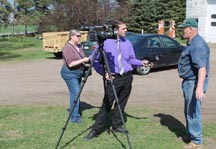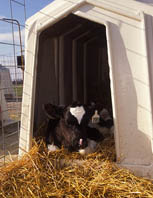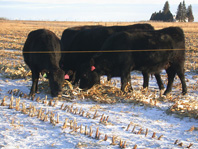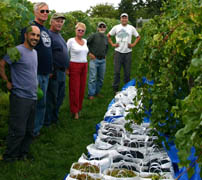The NNYADP has posted the results of the “Additional Innovations in Parasite Management in Northern NY Sheep and Goat Farms project conducted by Cornell Animal Science educators Michael L. Thonney and tatiana Stanton and NNY CCE Livestock Team Leader Betsy Hodge with assistance from NNY CCE Field Crops and Soils Specialist Kitty O’Neil. Learn more via the link that follows:
Media Highlight NNY Alfalfa Research Success

Regional media cover NNYADP alfalfa snout beetle control research success. . . WWNY TV 7 Patrick Malowski has posted his feature story on the Northern New York Agricultural Development Program-funded alfalfa snout beetle project success in using nematodes to control crop pest and the interest of 30 farmers in applying the insect-attacking worms to help protect their alfalfa crops, a valuable dairy industry feedstock.
The Mother’s Day edition of the Watertown Times features an article by reporter Elaine Avallone on a variety of alfalfa research funded by the Northern New York Agricultural Development Program. Cornell University Plant Breeder Julie L. Hansen is advancing the selection of ASB-resistant varieties of alfalfa. Her work led to the first commercial seed for ASB-resistant alfalfa. That seed was available for the 2nd year in 2015. Julie is also evaluating ways to improve the winter hardiness of alfalfa for NNY growers and ways to combat brown root rot of alfalfa.
Thanks go to farmer John E. Peck and the Peck Homestead Farm family who hosted the alfalfa snout beetle on-farm research trials for more than two decades in support of the long-term commitment required to develop a proper understanding of the pest, its life cycle and its predators. The protocol for using native NY nematodes as an inexpensive, effective biocontrol was developed by Cornell University Entomologist Elson Shields and Research Support Specialist Tony Testa. They devised a specific greenhouse process to support the research and field testing now shows that the nematodes will persist and spread, making it possible that a single application of the nematodes is enough to reduce pest populations to manageable levels.
The NNYADP dedicated funding, support of the NYS Legislature and the patient science-based research that has developed the use of nematodes combined with the selective breeding of ASB-resistant alfalfa varieties is writing a success story for Northern New York crop growers and the dairy industry.
NNY Site of 1st Birch Syrup Event, NYS Maple Tour
Northern New York counties are hosting two events of interest to syrup producers in 2015:
June 12-14: 1st International Birch Sap and Syrup Conference, Paul Smiths College in Franklin County, for those currently producing birch syrup and those interested to start up. Find a registration form at www.paulsmiths.edu/birch.
The farmer-driven Northern New York Agricultural Development Program has granted 2015 funds for a new project: Producing Syrup from Birch Trees in NNY: A Niche Marketing Opportunity for Sugarmakers.
June 28-30: 2015 New York State Maple Tour in Franklin and St. Lawrence Counties. Sugarhouses on the tour aboard air-conditioned charter buses include Parker Family Maple Farm, West Chazy; Moon Valley Maple in the Titus Mountain Ski Area near Malone; William Greenwood Maple; Jon and Kyle Laurie Maple; Rand Hill Maple, the only NY sugarhouse to make the Maple Almanac 2014 US Top Ten by Tap Count; Bechard’s Sugar House, Casey’s Sugar House, Saranac Sugar Works, Brow’s Sugar House, and Amazing Grace Vineyard making maple wine with Homestead Maple.
For information on the tour, activities, banquet, lodging and more, contact NYS Maple Producers Association at http://www.nysmaple.com/ny-maple-producers/2015-NY-Maple-Tour/. Also see June 28-30 listing at http://www.ccenny.com/index.php/calendar/events-calendar/.
NNYADP Announces 2015 Projects
The farmer-driven Northern New York Agricultural Development Program has announced 27 farm research projects for 2015.
The Northern New York Agricultural Development Program received $600,000 in State funding for the projects that cover a wide range of agricultural interests from evaluating emerging mastitis pathogens in dairy herds and early warning crop scouting for perennial and emerging diseases to Juneberry ‘superfruit’ production, and potential new high value crops for Clinton, Essex, Franklin, Jefferson, Lewis and St. Lawrence counties.

Farmers are cooperating with researchers from Cornell University, Miner Institute, Quality Milk Production Services, and Cornell Cooperative Extension to evaluate opportunities to enhance dairy calf health; and advance the production of crops from alfalfa, legumes, corn and oats to beef, birch syrup, edamame, apples, cold-hardy grapes, and amelanchier, also known as Juneberry, and other berries.
‘Every year we hear more and more reports from farmers that they are substantially saving on costs, time and labor as a direct result of the insights, information, and innovations produced by Northern New York Agricultural Development Program projects,’ says Program Co-Chair Joe Giroux, a dairy owner in Plattsburgh, Clinton County.
‘Northern New York Agricultural Development Program research supports the needs of our unique regional growing conditions, soils, and microclimates. The agricultural and environmental insight and results developed here benefit the economy both locally and statewide,’ said Program Co-Chair Jon Greenwood, a St. Lawrence County dairy farmer.

‘The Northern New York Agricultural Development Program produces a tremendous amount of information for the well-diversified agricultural interests across the region, from fruit to dairy to crops production and all aspects of farming with benefits to farms of all sizes,’ says Program Co-Chair Jon Rulfs, a partner in dairy and orchard businesses in Clinton County.
More than 130 farmers participate as committee members with the Northern New York Agricultural Development Program. The most recent Census data shows a total value of NNY farm products in excess of $752.8 million.

Funding for the Northern New York Agricultural Development Program is supported by New York State Senate leadership and is administered through the New York State Department of Agriculture and Markets.
Click here and scroll down for a complete list of NNYADP 2015 projects
NNYADP Posts Corn/Soybean Disease Survey Results
The farmer-driven Northern New York Agricultural Development Program has issued the results of a two-year project benchmarking common and newly-emerging diseases of corn and soybean crops in Northern New York.
Cornell University Plant Pathologist Gary C. Bergstrom led the research team that included Cornell Cooperative Extension field crop specialists Michael Hunter and Kitty O’Neil and 26 cooperating farmers scouting for diseases in NNY corn and soybean fields in 2013 and 2014.
The NNYADP Corn and Soybean Diseases Diagnosis and Assessment project found one disease of corn not seen in the region in more than 30 years: head smut, and one soybean disease new to New York state: northern stem canker.
Click here for the full press release on this project and its results.
NNYADP Corn and Soybean Diseases Diagnosis and Assessment project is posted here.
- « Previous Page
- 1
- …
- 62
- 63
- 64
- 65
- 66
- …
- 96
- Next Page »